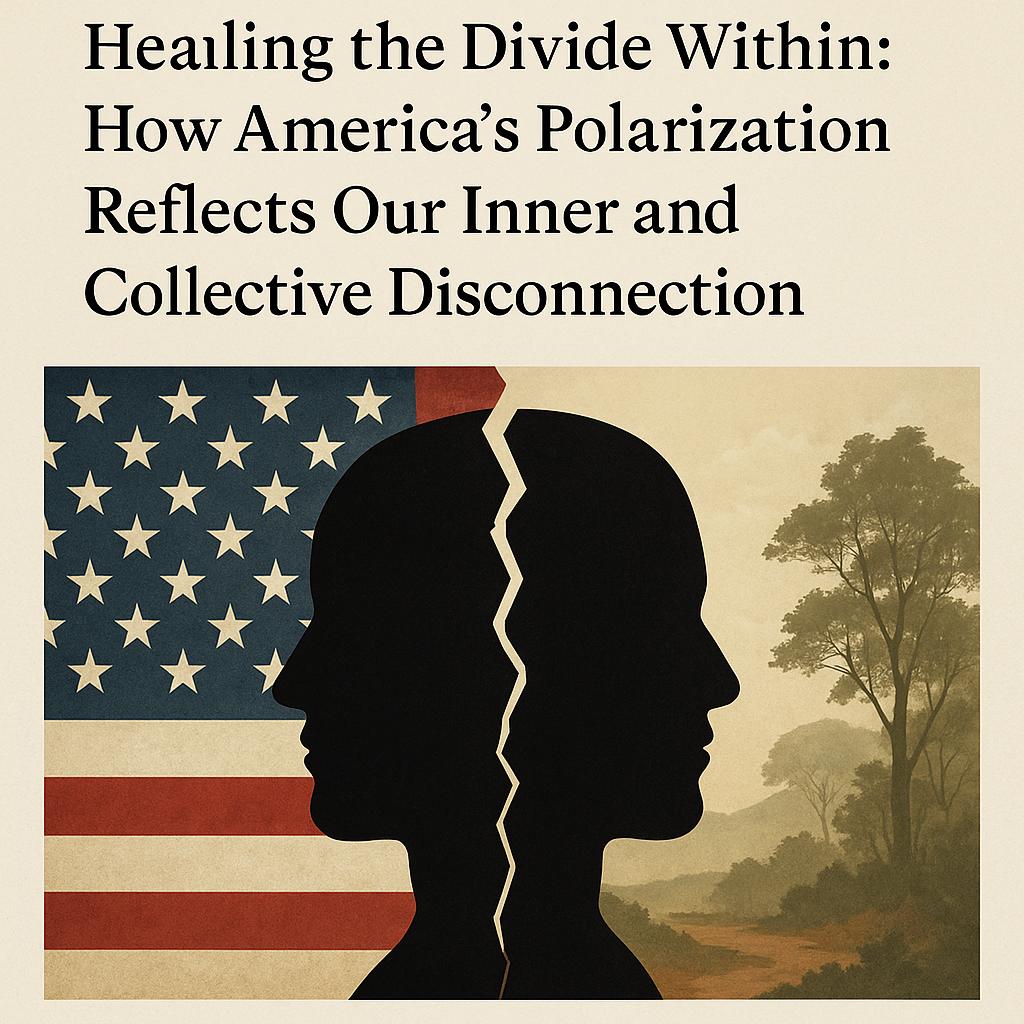The Great Divide Within: How America’s Polarization Mirrors Our Inner Disconnection

The Outer Divide Begins Within
Polarization often starts with fear—the fear of being unseen, unheard, or invalidated. On a societal scale, this fear becomes amplified, pushing us into tribes of “us” and “them.” But if we look closely, we can see the same mechanism at work within our own minds.
Psychologists call this splitting: the tendency to see things in extremes—good or bad, right or wrong, safe or unsafe. When we’re overwhelmed, our nervous system seeks simplicity. Complexity feels threatening, so we divide the world into opposites. This inner fragmentation mirrors the societal one. We push away parts of ourselves that feel uncomfortable or contradictory. Over time, we lose the ability to hold nuance, empathy, or paradox—the very qualities that help us stay connected, both inwardly and outwardly.
When a nation becomes polarized, it’s not just the country fracturing—it’s millions of internal worlds struggling to find balance.
Disconnection from Nature: A Mirror of Our Inner Ecology
Human beings evolved in relationship—with the land, with cycles of light and dark, with the rhythms of weather and growth. But in a culture of constant acceleration, many of us have drifted far from those natural patterns. We spend most of our lives indoors, looking at screens, losing touch with the sensory richness that once anchored us.
This disconnection from nature mirrors the disconnection within the self. Just as we separate from the natural world, we separate from our emotional landscapes. The quiet parts of our inner nature—the sadness, the stillness, the need for rest—are often labeled as “unproductive” or “weak.” We’ve internalized the same mindset that drives ecological destruction: the idea that we can control, optimize, or ignore what feels inconvenient.
Reconnecting with nature isn’t just environmental. It’s psychological. When we slow down enough to notice the wind in the trees or the rhythm of our breath, we are rejoining the world’s living systems—and, in turn, rejoining ourselves.
The Loss of Genuine Connection
Polarization also feeds on loneliness. Many people today feel more digitally “connected” than ever, yet emotionally more isolated. The nervous system, deprived of real presence, interprets isolation as danger. When we’re disconnected and dysregulated, we become more reactive—less curious, less compassionate, more defensive.
Social media algorithms amplify this vulnerability, rewarding outrage over empathy. But beneath that outrage lies something deeply human: the longing to belong. When we can’t find belonging in healthy, reciprocal relationships, we often seek it in ideological identities. These identities offer certainty—but at the cost of connection.
Real belonging is different. It’s found in moments of attunement—in being seen as a whole, complex person. In therapy, in friendship, or in a community grounded in empathy, we begin to heal that fragmentation.
Bridging the Divide: Healing from the Inside Out
Healing polarization—whether internal or societal—begins with slowing down enough to listen. In therapy, this looks like turning toward the parts of ourselves we’ve exiled: the anger, the grief, the vulnerability we’ve learned to hide. In society, it means practicing the same thing with others—listening not to agree, but to understand.
It’s not easy work. It requires humility and discomfort. But each time we choose curiosity over certainty, we soften the edges of division. We create a little more space—for ourselves, and for the collective nervous system we all share.
One client once described therapy as “coming home to myself.” That’s the opposite of polarization. It’s integration—the process of remembering that we are not separate, but part of a much larger web of life, history, and relationship.
Reconnection as Resistance
In a culture that thrives on distraction, disconnection, and division, slowing down and reconnecting is a quiet act of resistance. Reconnection doesn’t require perfection; it requires presence. It might look like:
- Taking a walk without headphones, letting the natural world recalibrate your senses.
- Speaking with someone who sees the world differently, without the goal of changing them.
- Turning toward your own inner contradictions with compassion instead of judgment.
Each act of reconnection is small, but collectively they become a movement—a way of remembering that healing isn’t just personal, it’s ecological and societal.
A Path Forward
At Tiffany Griffiths, Psy.D. & Associates, Inc. we believe therapy is one way to bridge these divides. Through compassionate exploration, we learn to hold complexity, to stay curious in the face of discomfort, and to rediscover the connections that make us human. The healing of our polarized world begins with the healing of our inner worlds.
If you find yourself feeling disconnected—from yourself, from others, or from the world around you—therapy can be a place to begin reconnection. Our therapists are here to walk that path with you.






